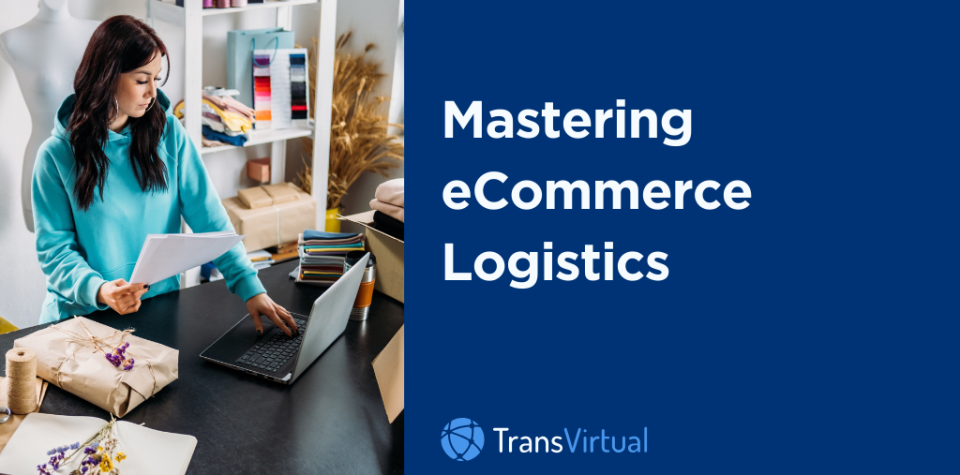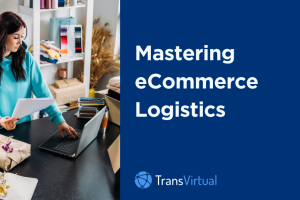Table of Contents
The further we move into the 21st century, the more ecommerce plays an essential part in global retail, sometimes being on par with brick and mortar stores.
Ecommerce brands are increasingly pivotal, as businesses everywhere are working to optimize ecommerce logistics to meet customer expectations. The more efficient your logistics operations, the greater the chance your products are delivered promptly to customers in a safe and cost-effective way.
The issue most businesses face in this area is managing their e commerce logistics. Everything from order management and inventory control to shipping and returns processing must be considered carefully.
In today’s blog, we’ll explore the key components of ecommerce logistics, the common challenges your business might encounter, and the practical solutions you can use to overcome them.
Defining eCommerce Logistics
Ecommerce logistics refers to the many systems and processes online retailers use in managing the flow of goods from a specific point of origin to the end customers.
This encompasses real-time insight into quantities across different locations and managing inventory levels for tax purposes, alongside order processing, inventory management, warehousing, packaging, shipping, returns management, and more.
The primary goal here is to ensure timely delivery while keeping shipping costs low.
Efficient logistics operations are critical for any business, but ecommerce businesses have to focus on it even harder in most instances.
The growth of online shopping has led customers to expect faster, reliable, and more affordable delivery options each year. With a well-organised logistics system, your business can meet these expectations and foster long-term customer loyalty.
The better your ecommerce logistics process, the easier it’ll be to reduce costs, optimise inventory levels, and improve your overall operational efficiency.
Key Components of Ecommerce Logistics
Order Management
Order management concerns processing your customers’ orders with precision and efficiency. It involves order validation, payment processing, and updating your new inventory levels after the order.
You can streamline order management by integrating your ecommerce platform with an inventory management system and shipping software. This way, you’ll be able to keep track of your sales, monitor performance, and make data-driven decisions to improve your operations while reducing the risk of human error and costly delays.
Inventory Management Software
Unless you run a dropshipping company or working a 3PL provider, you’ll have a product inventory on-site or in another storage center like a warehouse.
Inventory management is the method by which your business oversees and controls its storage, movement, and availability of goods within a warehouse or distribution center. To be successful, you need to maintain accurate stock levels, track your inventory’s movement, and optimise warehouse space and organisation. This is crucial for avoiding stockouts, overstocking, and dead stock.
Inventory management software is a crucial tool for monitoring low or excess inventory.
It’s also designed to fit into ecommerce logistics processes, providing real-time insight into quantities across SKUs and locations, and is essential for managing inventory outside the warehouse with features such as live inventory management and balancing inventory levels across different locations.
Some inventory management best practices many businesses use include implementing tools like barcoding and RFID technology alongside a warehouse management system to improve accuracy and reduce carrying costs. At the end of the day, you have to ensure your products are readily available to fulfill customer orders and generate a constant stream of profit.
Shipping & Fulfillment
During shipping and fulfillment, orders are prepared for delivery, appropriate shipping carriers and methods are chosen, and products are packaged securely to be shipped to customers in a timely manner.
Optimising this process is all about choosing reliable shipping partners, negotiating for more competitive rates, and implementing more efficient picking, packing, and labeling procedures.
You might also offer a range of shipping options for your customers (standard, expedited, same-day delivery, etc.) to help meet diverse customer preferences and improve their shopping experiences.
Challenges & Solutions for eCommerce Logistics Processes
1. Managing Multiple Sales Channels
As your ecommerce business expands, you’ll likely sell products across multiple platforms – your own website, online marketplaces like Amazon or eBay, as well as certain social media channels. You might find it challenging to integrate and synchronise your inventory across these platforms, which could lead to overselling, stock level inconsistency, and dissatisfied customers.
The best way to handle sales across multiple channels is to implement a centralised warehouse management system (WMS) to help your business efficiently manage its inventory. With a WMS, you’ll gain real-time inventory visibility, automatic stock updates, and a more streamlined order fulfillment process that ensures inventory levels stay accurate and consistent, no matter the platform.
2. Handling Returns & Reverse Logistics
Processing returns is time-consuming and costly – unfortunately, it’s almost always an unavoidable aspect of doing business.
That’s why you need an efficient system in place to help you handle returns, inspect and restock those returned items, and issue appropriate refunds or exchanges. Inefficiencies in your returns management can frustrate customers and increase your costs.
The solution here is to establish clear return policies and simplify the returns process to mitigate challenges associated with reverse logistics. An automated returns management system with pre-printed return labels as well as multiple return options (in-store returns, carrier pickups, etc.) can streamline returns for customers and reduce your logistical burden.
3. Scaling Logistics Operations
The more you grow, the more you’ll face the challenge of meeting increasing order volumes.
Such a strain on your existing infrastructure can create issues like longer fulfillment times and impact your customer satisfaction.
The best way to combat this and scale quickly and appropriately is to find an experienced ecommerce logistics partner. The right partner can provide access to advanced technology, a larger fulfillment network, and the expertise you’ll need to handle increasing order volumes. Partnering up like this means your business can focus on your core competencies while still making sure your customers receive a seamless and satisfying delivery experience.
Partner with eCommerce Logistics Experts at TransVirtual
Managing ecommerce logistics can be daunting, but choosing the right provider as a partner can make all the difference.
Partnering with a logistics expert like TransVirtual can significantly benefit your online store, providing comprehensive support from inventory management to ensuring efficient delivery to your customers.
Our highly professional team will work closely with you to gain an understanding of your unique goals. Then, we’ll help you develop a comprehensive strategy to improve your ecommerce logistics from top to bottom. No matter if you need help with inventory management, want to integrate with a quality warehouse management system, or simply want to tighten up your supply chain, we have the solutions you need to succeed.
For more information on making TransVirtual your ecommerce logistics partner, schedule a free strategy call with a member of our team today.



